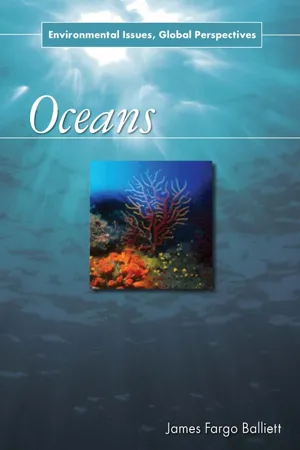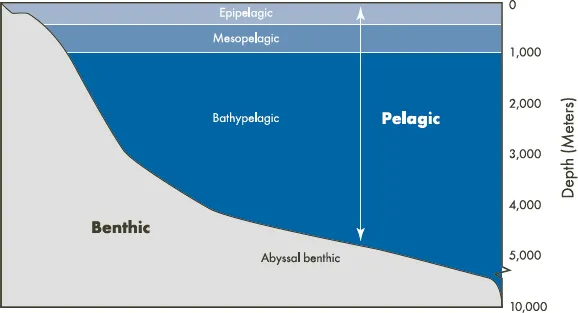![]()
![]()
Oceans are all around us. Of the 6.8 billion people who live on planet Earth, some 44 percent lives within 90 miles (145 kilometers) of an ocean. These vast bodies of salt water cover 71 percent of the planet and hold an estimated volume of 328 million cubic miles (1.37 billion cubic kilometers), or 343,423,668,428,484,681,262, or over 343 quintillion, gallons (approximately 1.4 sextillion liters, or the number 1.4 followed by 21 zeroes).
Oceans are a distinct part of human evolution and history. They were a source for some of the first forms of life and today support it in multiple ways, primarily through the maintenance of temperature equilibrium across the globe, the formation and influencing of weather patterns, and the long-term storage of waste streams, including carbon dioxide. The ocean environment also hosts a number of threats to humans, such as tsunamis, earthquakes, and storms.
Ocean Formation
The events leading to the creation of the world’s oceans date back to when the Earth was in its early stage of formation. Roughly 4.3 billion years ago, the molten surface of the planet began to cool into a landscape of sunken lowlands, mountains, and uplands. Vast plumes of hydrogen and methane steam that had been trapped underground were driven by heat and pressure into the atmosphere. This steam was laden with minerals such as calcium, chlorine, magnesium, and sodium sulfate, as well as other chemicals. The Earth also was impacted by thousands of large and small meteors that deposited considerable amounts of rock, heavy with water vapor, onto the planetary surface.
As clouds of gaseous materials collected above the land, the first atmospheric conditions triggered rainstorms. These lasted, off and on, for millions of years, and the first large bodies of water formed.
Rivers on higher ground drained into the lower lands, eventually filling into ocean-sized bodies. Massive amounts of sediment and minerals were washed downward as well. This downward flow and that of rainwater, which mixed with dissolved salts from bedrock, are why the oceans are saline.
Deep in submerged canyons were underwater volcanic vents releasing lava and plumes of carbon dioxide and hydrogen. It was here, in an underwater environment, about 3.5 billion years ago, that the building blocks of living creatures most likely formed.
This ocean event is key to abiogenesis, the study of how life on Earth arose out of inanimate chemicals. Prevalent volcanic discharge, rich in ammonia and hydrogen sulfide, mixed with salt water and altered floating metal particles such as iron and nickel. These organic compounds formed small molecules, which eventually combined to form chains of amino acids. These amino acids played a role in the eventual creation of single-celled animals, many of which evolved into oceanic multicellular organisms, including plankton, plants, fish, and other animals.
HYDROTHERMAL ORIGIN OF LIFE
German chemist Günther Wächtershäuser proposed in 1997 that the following conditions allowed for the creation of the building blocks of life:
1. Water environment, preferably saline
2. Temperatures between 100 and 250 degrees Fahrenheit (38 and 121 degrees Celsius)
3. Presence of iron, nickel, and cobalt sulfide
4. High pressure of a deepwater environment
5. Presence of superheated carbon monoxide
Wächtershäuser concluded that in these conditions, certain metals catalyze the binding of basic carbon molecules into more complex molecules. Mineral-based chemistry, in the right conditions, forms biologically active organic life. While this theory shows promise, the exact source of life on Earth may never be known, because these events occurred billions of years ago and cannot be proven.
By 500 million years ago, the oceans had reached a size similar to that of today. Even though water now covered 71 percent of the planet, the land under the water still was in a state of constant change, being altered by a range of geologic forces. Fifteen major tectonic plates (and up to forty-one smaller ones) served as the outer rock layer on the planet.
In 1912, the German scientist Alfred Wegener hypothesized that, around this time, the continental plates had formed into one mass, called Pangaea (meaning “ancient Earth” in Greek). This single amalgam of land straddled the equatorial region of the Earth, surrounded by a superocean that Wegner called Panthalassa (meaning “all seas” in Greek).
About 20 million years later, Wegener theorized, Pangaea rifted, or split, and new ocean floor began forming. Pangaea’s pieces—the Earth’s continents—have been moving away from each other ever since. It took half of a century for another scientist, American oceanographer William Maurice Ewing, to prove Wegener’s hypothesis of continental drift.
Beginning in the 1950s, Ewing extensively surveyed the ocean bottom. His use of sonar waves to “see” the contours of the ocean ridges and slopes revealed an active massive undersea ocean rift—a large underwater mountain range emerging from a divergent boundary between two tectonic plates—at the bottom of the Atlantic Ocean. Ewing recorded multiple earthquakes and the presence of new magma emerging from the rift itself, forming undersea mountain ranges. Ewing also recorded the collisions of plates of varying densities in other locations, where they formed massive subduction zones; bedrock was compacted and then pressed back into the planetary crust, where it eventually was remelted into magma.
This diagram illustrates the Earth’s continental drift, including the fragmented Pangaea, or “ancient Earth” that existed 500 million years ago. Since then, the plates broke apart and have moved to their current formation at a rate of up to 6 inches (15.2 centimeters) per year. (DEA/ D’Arco Editori/De Agostini/Getty Images)
This cycle of formation and destruction of continents and ocean floor has occurred multiple times over the last 2 billion years. In another 30 million years, the Atlantic Ocean will be larger, the Pacific Ocean will be smaller, and a number of other oceanic tectonic changes will have occurred.
The Physical and Chemical Oceans
Although there are five distinct oceans (Arctic, Atlantic, Indian, Pacific, and Southern), these bodies of salt water are not separate. They combine to form what scientists term the World Ocean, a global expanse that covers about 139 million square miles (360 million square kilometers). The World Ocean is approximately 300 times larger than all upland combined. Given this proportion, this planet might have more aptly been named “Oceanus” and not “Earth.” In fact, if the entire surface of the planet were flat, ocean water would cover the surface to a depth of 12,000 feet (3,658 meters).
More than 60 percent of the Earth’s total landmass is found in the Northern Hemisphere, while less than 40 percent exists in the Southern Hemisphere. More than half of the oceans exceed 10,000 feet (3,048 meters) in depth, and the average depth is 12,430 feet (3,789 meters). The deepest known location, in the Mariana Trench in the western Pacific Ocean, is approximately 36,201 feet (11,034 meters) underwater.
All oceans are composed of salt water, which makes up 97 percent of the Earth’s water supply. This water has a salinity content that ranges between 3.1 and 3.8 percent and is rarely uniform, especially where freshwater and salt water mix at river mouths, at estuaries (semi-enclosed coastal water bodies), or near glaciers or ice floes. The pH (measure of acidity) of ocean water ranges from 7.8 to 8.5.
| GLOBAL OCEAN SIZES |
| Ocean | Size (Million Square Miles) |
| Arctic | 5.44 |
| Atlantic | 33.50 |
| Indian | 26.90 |
| Pacific | 65.60 |
| Southern | 7.85 |
| Total: | 139.29 |
Seawater is composed of a number of elements that are dissolved in varying concentrations. A common formulation contains 85.4 percent oxygen, 11.5 percent hydrogen, 1.9 percent chlorine, 1 percent sodium, 0.09 percent sulfur, 0.04 percent calcium, 0.04 percent potassium, 0.006 percent bromine, and 0.002 percent carbon.
Humans cannot survive on salt water alone, because the ingested concentration of sodium chloride requires additional freshwater to process and eliminate it, resulting in dehydration. Ocean fish, birds, mammals, and other sea creatures have evolved to manage the salty conditions, and their bodies can eliminate salts.
Oceans host unique underwater environments that vary, depending on their depth, bottom surface conditions and composition, water temperature, currents, and proximity to land. The ocean, as viewed in a cross section, is divided into multiple horizontal and vertical zones. The two main ones are divided horizontally and include the benthic realm, which forms the ocean floor environment, and the pelagic realm, which includes any area above the ocean floor.
Life in Oceans
Approximately 3.5 billion years ago, salty warm waters hosted a unique habitat, as they were surrounded by erupting volcanoes and skies filled with an atmosphere made from a combination of sulfur, carbon dioxide, nitrogen, and methane (which would be highly poisonous to any oxygen-dependent animals, such as humans). Despite these conditions, some of the microbial species, known as phytoplankton, evolved over millions of years to eventually take in carbon dioxide and produce oxygen as a by-product. This critical contribution helped create an environment where a broader diversity of oxygen-dependent water and land species could exi...



